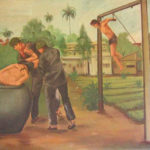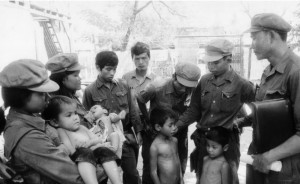This past week at the UN-backed Tribunal in Cambodia, survivors of the Khmer Rouge’s infamous Tuol Sleng ‘S-21’ facility gave chilling accounts of the tortures they endured and witnessed – and in two cases, how their artwork saved them.
The testimony comes as part of the trial of the former head of internal security and S-21 Kaing Guek Eav (widely known as ‘Duch’), for war crimes, crimes against humanity, homicide and torture committed during Pol Pot’s 1975-79 ‘Year Zero’ campaign, when approximately 1,700,000 Cambodians died.
Only a handful of people survived Tuol Sleng (estimates range from six to 15) the high school-turned prison camp, where after being captured, photographed, interrogated, tortured and starved, approximately 15,000 Cambodians lost their lives.
The witnesses’ declarations in court were linked not only by the similarly disturbing details, but also by the fact that each witness praised the court and showed their appreciation for its healing function – something all international tribunals should look to.
Life spared because Duch liked his Paintings, Monday June 29th
Artist Vann Nath testified that in 1977 he was arrested, interrogated and tortured by means of  electrocution. In the months he spent in a Tuol Slang cell with about 50 other prisoners, they ate insects that fell from the ceiling to survive.
electrocution. In the months he spent in a Tuol Slang cell with about 50 other prisoners, they ate insects that fell from the ceiling to survive.
Moved to better quarters after Duch liked the Pol Pot portraits he was forced to paint, Vann Nath testified that Duch often visited his workshop; because it was within ‘screaming range’ of prisoners, this testimony linked Duch to the crimes alleged.
Now displayed in the Tuol Sleng museum, Vann Nath’s more recent artwork – showing the sexual abuse, electrocution, waterboarding, throat slitting, and ripping out fingernails that occurred at S-21 – serves as a reminder of the horrors that took place there.
Vann Nath’s full testimony can be viewed here: Part I, II, III, IV, V, VI
Shocked with exposed wire until he ‘confessed’, Tuesday June 30th
Mechanic Chum Mey described horrific scenes of his torture – he was shocked with exposed wire running to his ear, had his toenails torn out, was beaten with sticks, and kept in a room dirtied with fresh blood, until, as requested, he ‘confessed’ he had joined both the CIA and KGB.
Though he never saw Duch, his testimony went towards disproving Duch’s claim that most interrogations were ‘cold’ – i.e. did not involve torture.
Kept alive to work as a mechanic, he fled in 1979 and was by chance reunited with his wife and newborn son – both subsequently shot and killed by ‘militia’.
Chum Mey’s testimony can be viewed here: Part I, II, III, IV, V, VI, VII
‘Hell on earth’ and Pol Pot Paintings, Wednesday July 1st
Artist Bou Meng described the conditions of S-21 as ‘hell on earth’ – there he was beaten with sticks, whipped, and electrocuted with a wire attached to his inner thigh until he signed a ‘confession’ that he had joined the CIA. He only survived because, like Witness Vann Nath, Duch liked his paintings – black and white portraits of Pol Pot, Kim Il Sung and Mao Zedong, and Ho Chi Minh’s head on the body of a dog.
Also like Vann Nath, Bou Meng linked Duch to the workshop, and thus very close to the screams of torture taking place outside.
Bou Meng asked Duch where his wife was murdered so he could finally “pray for her soul”. While Duch responded that he did not know, he began to cry after answering that it was probably Choeung Ek killing field (a field used for nearly 17,000 executions outside Phnom Penh).
Bou Meng’s testimony can be viewed here: Part I, II, III, IV
Nine year old prisoner of Tuol Sleng, Thursday July 2nd
 Only 9 years old in 1978, Norng Chan Phal described how, after watching his ill mother being severely beaten, he and other small children were put into the care of an elderly woman by the workshop. When the Vietnamese bombarded Phnom Penh in 1979, he went looking for her, but found only the horrific scene of several dead bodies, covered in flies.
Only 9 years old in 1978, Norng Chan Phal described how, after watching his ill mother being severely beaten, he and other small children were put into the care of an elderly woman by the workshop. When the Vietnamese bombarded Phnom Penh in 1979, he went looking for her, but found only the horrific scene of several dead bodies, covered in flies.
Duch disputed that Chan Phal was ever at S-21, as all children there had been ordered killed.
Another S-21 survivor will testify on Monday, July 6 – for their protection, witnesses names are not being released in advance.